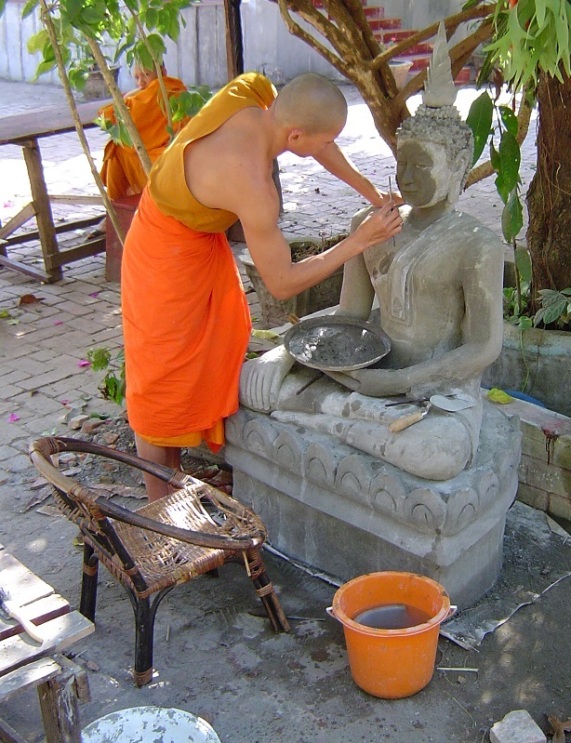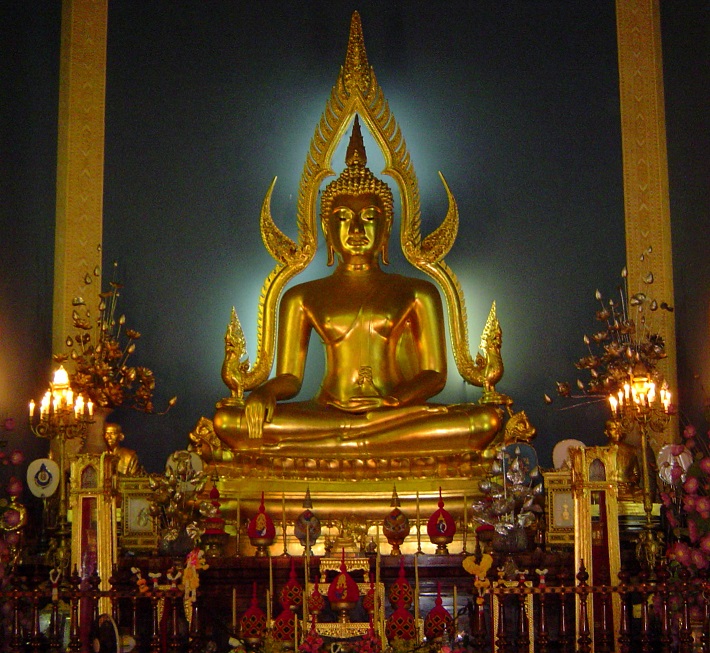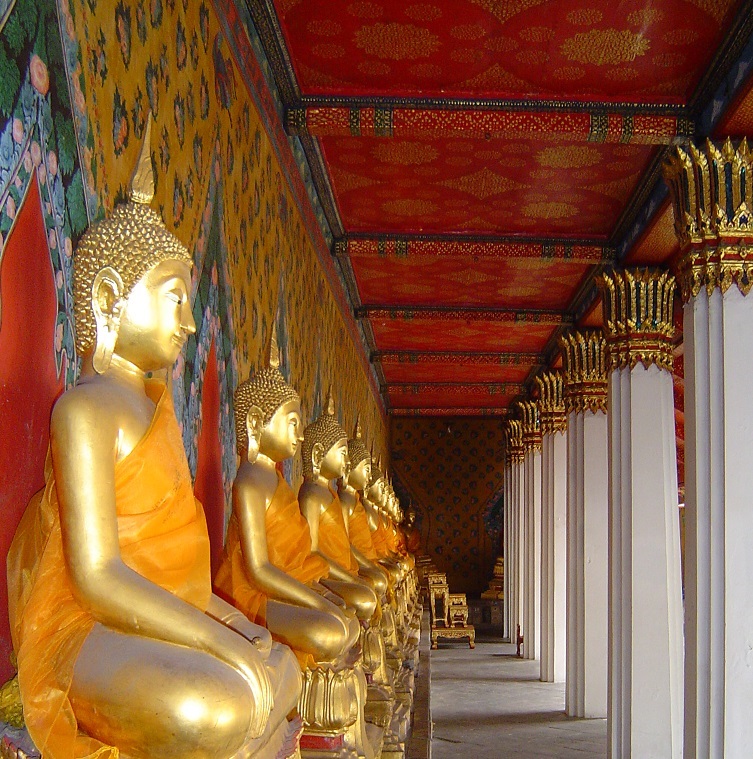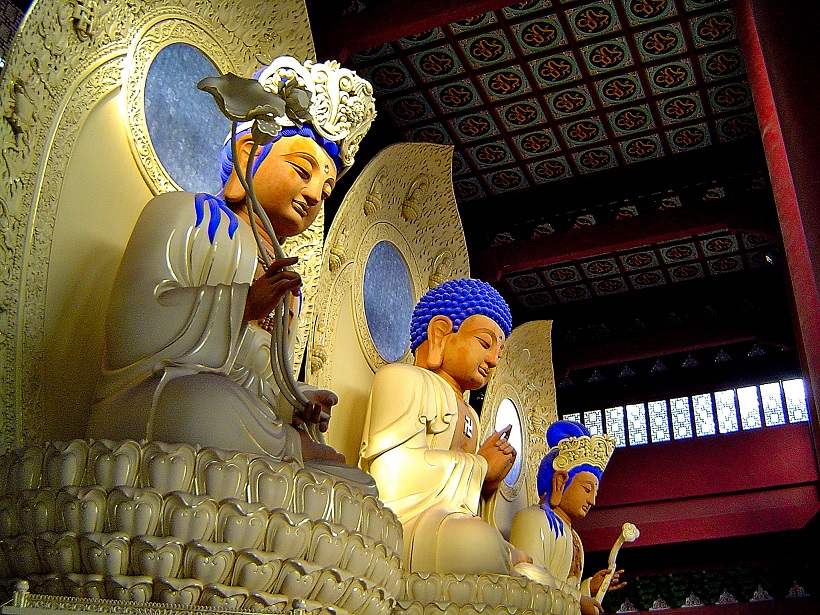For the curious observer of art and culture, a study of religious icons is both a visual and intellectual feast.
Over millennia, the world’s dominant organized religions — with the clear exception of Islam — have relied heavily on the use of iconography as a teaching tool to reinforce their respective belief systems.
In my world-wide wanderings, I’ve observed local believers performing personal rituals and exhibiting varying levels of reverence for such icons found in churches, temples and shrines. As a lover of all handcrafted objects, I’ve also scrutinized the colors, textures and forms used to influence the faithful.
Religious icons can elicit emotions that run the gamut from uplifting and serene to shocking and psychologically disturbing. The latter is particularly true of Christian icons representing the crucifixion of Jesus Christ in all its graphic horror.
In Catholicism the priesthood has traditionally been the conduit through which the masses were taught religious dogma while the descriptive (and ornate) statues and paintings placed in churches have reinforced their teachings.
Buddhism, on the other hand, has chosen a slightly less confrontational and more philosophical approach by using highly stylized and symbolic paintings and sculptures of an imagined historical Buddha demonstrating various hand gestures (mudras), physical attributes and postures (sitting vs standing) that carry profoundly symbolic meaning.
Buddhist iconography isn’t intended to approximate the historical Buddha’s (Buddha Shakyamuni or Gautama Buddha) physical features, rather the symbols used are meant to depict the Buddha’s expanded range of knowledge and awareness after enlightenment.

A young monk sculpting a Buddha image at a temple in Luang Prabang, Laos. Photo: Henry Lewis
Symbols in Buddhist Iconography
While this post focuses on hand gestures, additional elements of Buddhist iconography to be aware of while viewing the following photos are:
- Lotus blossoms and leaves — In Buddhist iconography, the lotus is a a symbol of enlightenment, the state of freeing oneself from the cravings of our physical and material world as well as from the cycle of birth and rebirth as taught in Hinduism which preceded Buddhist thought.
- The Naga — As the story goes, during the historical Buddha’s internal journey to enlightenment, he was protected from the elements by a Naga (serpent in Sanskrit), often portrayed as a seven-headed snake. Despite being highly stylized and having multiple heads, the serpents’ intimidating hood flares — expanded necks forming a sort of hood — remind me of the common cobras found all over Southeast Asia.
- The eyes on Buddhist figures are often slightly open with a downward gaze, indicating a state of internal meditation while still remaining aware of the outside world.
- Conversely, an icon’s eyes may be looking outward, representing the historical Buddha’s compassion for all sentient beings in our earthly realm as well as depicting the Buddha as a teacher who was fully engaged with his students.
- The shape of an icon’s head — In most Buddhist traditions, figures representing the historical Buddha have a protuberance (an Ushnisha in Sanskrit) crowning the top of the head. This protuberance represents knowledge and wisdom and may range in size and general shape from one part of East Asia to another.
- Long earlobes — Indicate the Buddha’s great willingness and ability to hear the cries of other sentient beings.
Buddhist Mudras
A mudra — a specific positioning of the hands — is used in Buddhist art (as well as in practice) to evoke a particular state of mind. Indeed, many scholars refer to Buddhism as a ‘science of mind’ with little of the religious dogma inherent in other world religions.
Some mudras are easily recognizable due to the international proliferation of Buddhist icons and various forms of meditation made popular in Western culture over the past few decades, while other mudras convey a deeper level of teaching and philosophical understanding.
The Dhyana Mudra
The Dhyana mudra is commonly used as a hand gesture in yoga and Buddhist meditation practices. It is predominantly seen on figures sitting cross-legged in what we commonly call the lotus position.
In this mudra, the hands are placed on the lap with the fingers of the right hand extended and resting directly on the outstretched fingers of the left hand. The thumbs of each hand are typically, although not always, touching.
Photo 1

A Buddha statue sitting in the lotus position with eyes gazing downward. The hands are placed in the Dhyana mudra, often used in yoga and other meditation practices. The 7-headed Naga above the Buddha forms a sort of umbrella, offering shelter from both tropical sun and rain. This particular image was situated in an outdoor temple garden in Phnom Penh, Cambodia. Photo Credit : Henry Lewis
Photo 1.1

This Thai Buddha — seen at night in Bangkok — is a typical example of how the Dhyana mudra is used in Buddhist iconography to guide adherents in their meditation practice. Photo: Henry Lewis
The Dhyana mudra is particularly important as it represents the prolonged period of deep meditation the historical Buddha undertook in order to reach enlightenment.
The Abhaya Mudra
The Abhaya mudra is formed with the figure’s right arm bent and the hand held at shoulder height. The palm of the hand is open with fingers extended. The left hand is held down in a more relaxed position.
This mudra — both indicating fearlessness and blessing — represents the protection, peace, benevolence and dispelling of fear offered to practitioners who study the teachings (dharma) and actions of the historical Buddha.
Photo 2

A statue representing the historical Buddha illustrating the Abhaya mudra with right hand raised and palm open, while the left hand is held down. This specimen was found at a rural temple in Thailand. Photo: Henry Lewis
Photo 2.1

The historical Buddha depicted leading a long line of his students. He is shown using the Abhaya mudra which illustrates the Buddha’s fearlessness and protection of those who follow the teachings. I took this photo at a temple in Tachileik, Myanmar, just across the border from the Thai town of Mai Sai, and its namesake river. Photo: Henry Lewis
While the Ushnisha is high and sharply pointed on Buddha sculptures found in Thailand, Laos and Cambodia, the more rounded shape of the head crown on the Burmese Buddha in photo #2.1 shows the stylistic influences of nearby China.
The Bhumisparsa Mudra
The Bhumisparsa mudra is also known as the ‘touching the Earth’ mudra and represents the moment of the historical Buddha’s awakening as he claims the earth as the witness of his enlightenment. It is formed with the right hand held on the right knee, reaching toward the ground with the palm inward, and often touching the lotus throne on which the Buddha traditionally sits.
Photo 3

The Buddha featured in this Thai temple shrine is performing the Bhumisparsa Mudra, also known as the ‘touching the earth’ mudra. Photo: Henry Lewis
Photo 3.1

A long line of Buddha’s seen here at a temple in Vientiane, Laos all performing the Bhumisparsa (touching the earth) mudra. Photo: Henry Lewis
The Uttarabodhi Mudra
The Uttarabodhi Mudra denotes the supreme enlightenment by connecting oneself with divine universal energy. It is performed by joining both hands, placed at the heart with the index fingers touching and pointing upwards and the remaining fingers intertwined.
Photo 4

Three beautiful symbolically stylized Buddhist figures found in the Huayan Hall of the Lingyin Temple and Monastery near Hangzhou, China. The Buddha in the center of the trio is performing the Uttarabodhi mudra. Photo: Henry Lewis
Chinese Buddhas (above) are often depicted with blue hair, a color which signifies the concept of loving kindness. Note the round shape of the head on the Buddha figure in the center of the trio in contrast to the high, pointed crown depicted on Buddha sculptures in much of Southeast Asia.
For more on this specific trinity of Buddha statues, see the three sages of the Avatamsaka Sutra — Manjusri, Shakyamuni and Samantabhadra.
The Dharmachakra Mudra
The Dharmachakra mudra signifies teaching, and is usually interpreted as ‘the turning of the wheel‘ of the dharma. This gesture also represents a great and revolutionary change with universal consequences.
This mudra is performed by holding the hands at the level of the heart with index fingers and thumbs touching and forming circles.
Photo 5

This large sitting Buddha, located near the entrance to the UNESCO listed Dambulla Royal Cave Temple in the central highlands of Sri Lanka, is performing the Dharmachakra mudra. This mudra represents teaching the dharma or the ‘turning of the wheel.’ Photo: Henry Lewis
Considering the demon’s mouth that forms the doorway to the Golden Temple — directly below the sitting Buddha — in photo 5, perhaps the following mudra would also be appropriate here.
The Karana Mudra
The Karana Mudra symbolizes the expelling of demons. In the following photo, we can see how different mudras may be combined in order to strengthen the message represented by a Buddha icon.
The Buddha’s right hand forms the Abhaya (protection) mudra, while the left hand approximates the Karana mudra. Therefore, this Buddha statue radiates both protection and the expelling of demons.
Photo 6

This beautiful white marble Buddha in Penang, Malaysia combines two mudras — the Karana (expelling demons) mudra with the left hand and the Abhaya (protection) mudra with the right hand. The Karana mudra may be formed with the hand facing up or down. Photo: Henry Lewis
Varying traditions and schools of Buddhist thought also help explain the use of multiple symbols in Buddhist icons. Note the circle in the center of Buddha’s right palm in photo #6 which represents the wheel of dharma.
The Vitarka Mudra
The Vitarka mudra symbolizes intellectual argument and discussion. This gesture is configured with the palm facing forward and the index finger and thumb touching, which then form a circle.
Photo 7

This intricately carved Buddha found in the Mahavira Hall of Lingyin Temple in Hangzhou, China has its right hand raised in the Vitarka mudra, indicating intellectual argument and discussion. Photo: Henry Lewis
Historical Buddhist teachings encourage intellectual argument and discussion. In Tibetan Buddhism, debate is considered the key to dispelling misconceptions and establishing a defensible view of the dharma.
Final Thoughts
Like other great world religions, the origins of Buddhist teachings are themselves debatable.
In 2001, I had the opportunity to hear one of the foremost academics in Buddhist studies speak. After the lecture, I sidled up beside the professor and timidly asked what the research had indicated about the origins of the teachings of the historical Buddha.
The highly respected academic smiled and noted that none of the historical Buddha’s teachings were written down and codified until approximately 300 years after his death. By that time, the expert emphasized, there were already 11 different ‘schools’ of Buddhist thought.
So, perhaps it’s best to enjoy the art and cultural significance of religious icons without attributing too much validity to the messages such icons carry.
peace~henry



An incredible and highly evolved religion I think 🙂
LikeLiked by 2 people
Hi Ogden,
Yes, it is in many ways. I especially appreciate the connection between the principals of modern physics and ancient Buddhist teachings.
LikeLike
Great post!
LikeLiked by 3 people
Thanks, glad you enjoyed!
LikeLiked by 1 person
I did and you are most welcome! 🙂
LikeLike
Thanks for this informative post, Henry 🙂 I was not aware of the diverse symbols used in Buddhist iconography. Buddhist thought brings its own enlightenment to our world.
LikeLiked by 2 people
Hi Rosaliene,
“Buddhist thought brings its own enlightenment to our world.” Thanks as always for your keen insights.
LikeLiked by 1 person
What a great post. Thank you so very much.
LikeLiked by 3 people
Thank you Gigi!
LikeLike
Thanks for sharing your insights into the mudras. I’ve noticed the various gestures many times and thought they were telling. But, I only could guess. Symbolism is powerful in every culture.
LikeLiked by 2 people
Hi Jim,
Yes, I agree. Symbolism — especially of the religious variety — is indeed powerful in every cultural and opens a fascinating window into the hearts and minds of the local population. Hope you and yours are well these days!
LikeLiked by 1 person
I’ve read all of the poses and hand positions many times before but this is one of most concise, easy to understand descriptions I’ve read. The accompanying pictures are a real help too. Maggie
LikeLiked by 2 people
Hi Maggie,
Thanks so much for saying that. My desire was to simplify the explanations as much as possible. I’ve long been fascinated by Buddha images and the messages they carry within each country’s cultural context, so I wanted to share a bit of my own enthusiasm on the topic. Take good care!
LikeLiked by 1 person
This reminds me of my childhood when I learned from a book about the different mudras depicted at Borobudur. I still can’t remember them all, though. In Hinduism, different hand and body gestures also indicate different meanings, and some can only be found in certain regions. For example, in southern India Shiva is often depicted as Nataraja. As far as I’m aware of, this form is not common in northern India and Indonesia.
LikeLiked by 2 people
Hi Bama,
Thanks for adding your insights. Since the development of Buddhism was essentially a reaction to Hinduism, it makes sense that some symbols and practices would be borrwed. From my point of view, you had a fascinating childhood –studying the mudras from Borobudur. I would love to go there.
LikeLike
Interesting article Henry.
LikeLiked by 2 people
Thanks Kevin. Hope all is well in your world!
LikeLike
In the end, the Christian representations also have codes, but their reading seems more direct.
LikeLiked by 2 people
Yes, I agree. Buddhist codes seek to connect the faithful with a higher plane, while the codes carried via Christian icons engage on a quite visceral level–the blood of Christ etc. Thanks for your comments!
LikeLiked by 1 person
Another fascinating and educational post, Henry!
LikeLiked by 2 people
Thanks you guys. Hope all is well in El Retiro!
LikeLike
Beautiful photos, Henry, from your world travels! Thanks for the descriptions. I learned several Buddhist ideas I hadn’t known before; abhaya mudra and karana mudra, protection and expelling of demons. Very interesting!
LikeLiked by 2 people
Thanks Rebecca. I learned as well while researching this post. Enjoy your Sunday.
LikeLiked by 2 people